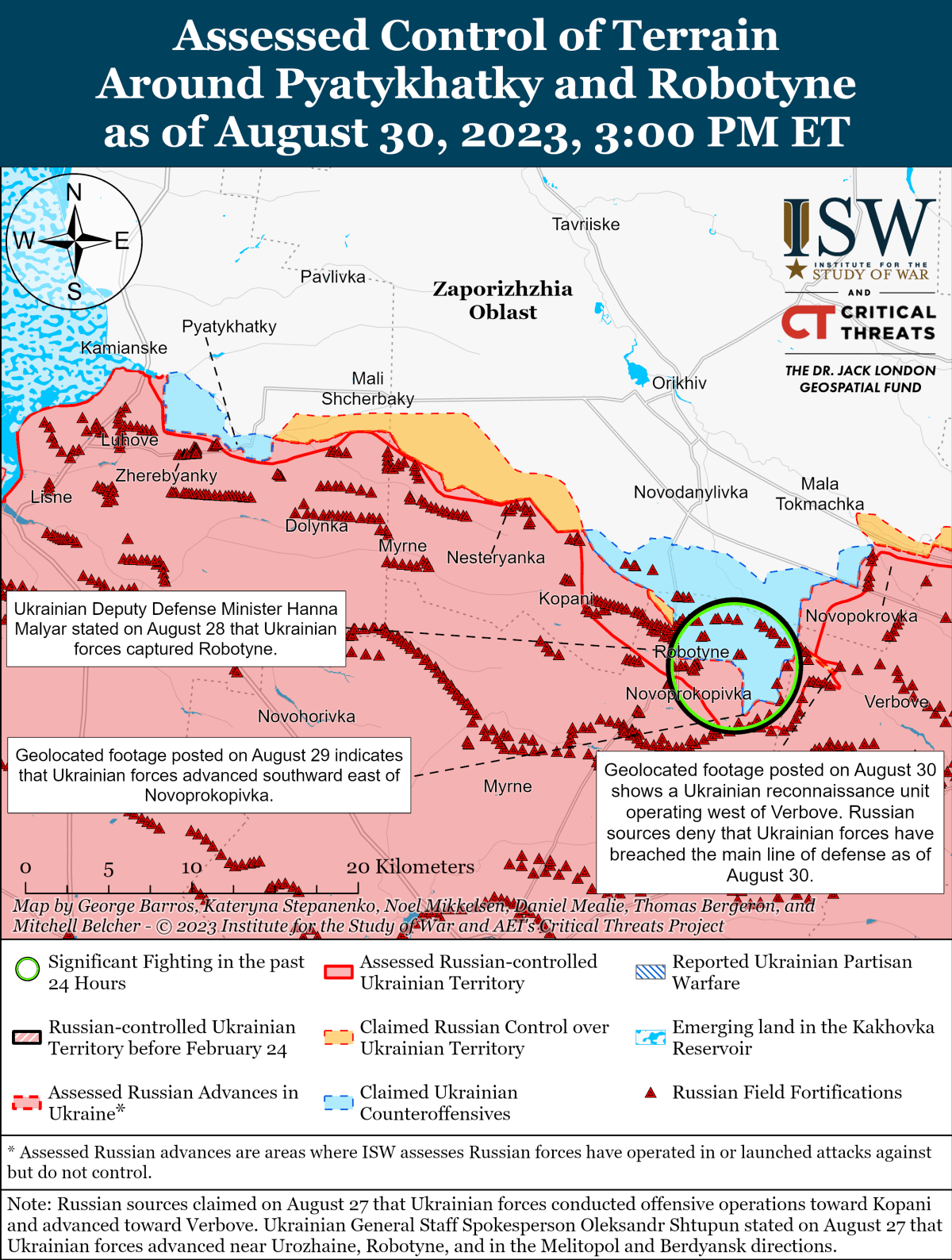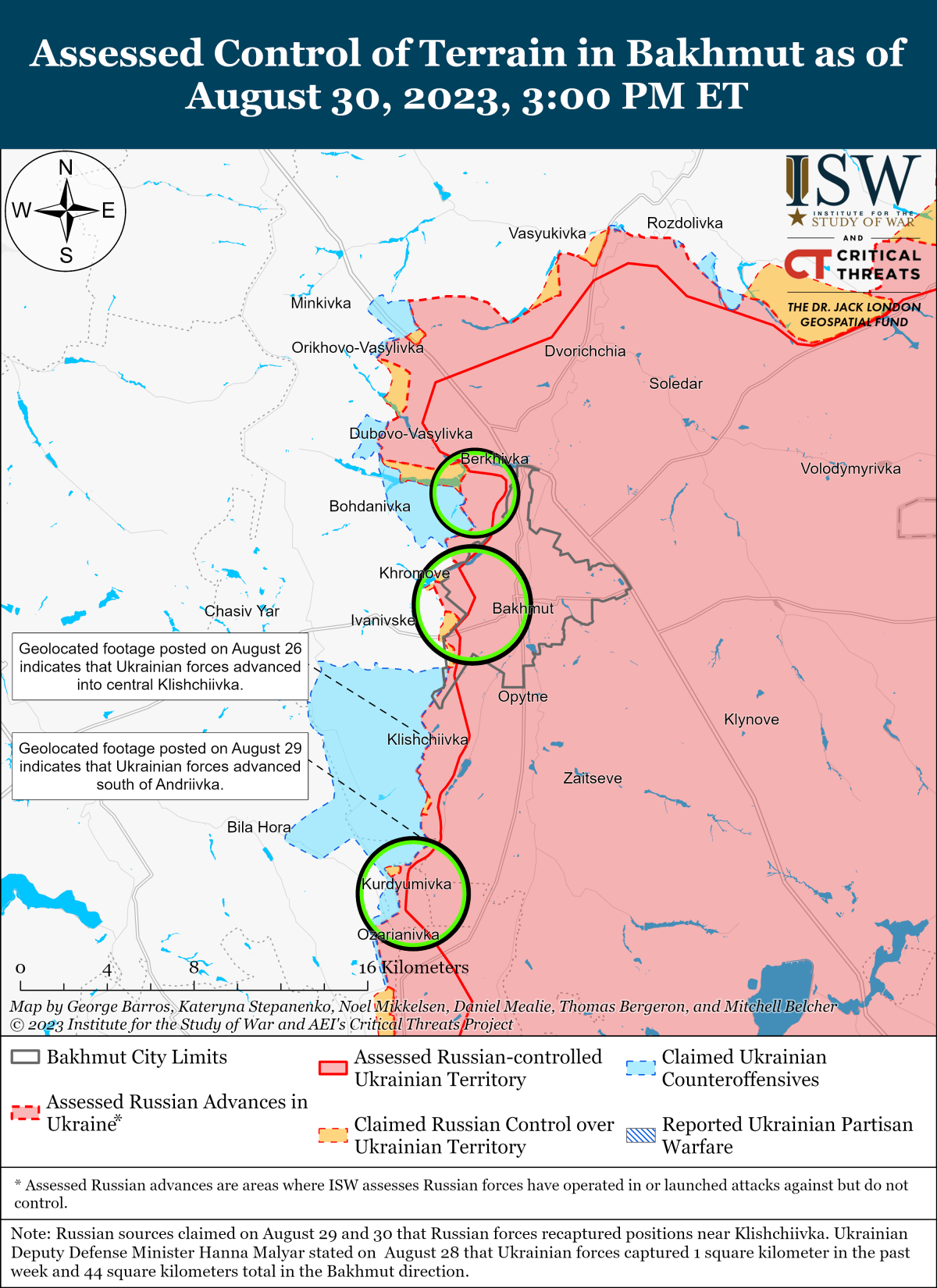Happy Thursday! A man was pulled over in Norfolk, Nebraska, yesterday for driving with a several-hundred-pound Watusi bull—named Howdy Doody, apparently—riding shotgun in his Ford sedan.
We hope the two were still able to make it to the Cornhuskers’ volleyball game against Omaha, which broke a record on Wednesday for the largest live crowd to ever witness a women’s sporting event.
Quick Hits: Today’s Top Stories
- Hurricane Idalia made landfall in Florida Wednesday morning as a Category 3 hurricane, slamming the state’s Big Bend coast with rain and winds up to 125 mph. Three deaths have been attributed to the storm thus far—two from car crashes and one from a downed tree—and the system was downgraded to a tropical storm as it moved across Georgia and into the Carolinas overnight.
- Ukraine launched a large-scale attack in southern Russia last night, with drones striking six different regions, causing significant damage to a military airport in one of them. Russia had launched an overnight strike, sending a barrage of 28 missiles and 16 drones to attack Kyiv early Wednesday morning and killing two people, according to the Ukrainian military.
- Military leaders seized power in Gabon yesterday, detaining President Ali Bongo in the Central African oil-producing country. Gabon’s electoral commission had declared Bongo—whose family has been in power for more than 50 years—the victor of the country’s recent disputed election. The coup leaders claimed the vote was illegitimate and installed Gen. Brice Oligui Nguema—the leader of the Republican Guard—as the president of a transitional committee to head the country.
- The Department of Health and Human Services recommended to the Drug Enforcement Agency on Tuesday that marijuana be reclassified as a less restricted substance under the Controlled Substances Act. The agency recommends the drug be moved from Schedule I to Schedule III, which would put it in a class with drugs that are considered lower risk and can be purchased legally with a prescription. If the DEA makes the change, businesses that sell marijuana will be able to take advantage of tax exemptions—such as salaries and benefits—that are currently unavailable to do while selling a Schedule I drug.
- American Airlines flight attendants voted to authorize a strike yesterday, empowering their union to call out its members—99 percent of members voted for the authorization. The union is currently negotiating pay raises with the airline. Federal law prevents airline workers from striking unless the National Mediation Board—an independent federal labor-management relations agency—allows it.
- The United States approved an $80 million military aid package to Taiwan Wednesday under the Foreign Military Financing program—a route typically used to provide aid to sovereign states. The State Department said that the use of the program did not reflect a change in America’s stance toward the island democracy—the U.S. “one China” policy does not recognize Taiwan as an independent nation.
- The State Department warned American citizens to leave Haiti yesterday. “Given the current security situation and infrastructure challenges, U.S. citizens in Haiti should depart Haiti as soon as possible via commercial or private transport,” the U.S. Embassy in Haiti said in a security alert yesterday. The embassy evacuated nonessential staff last month. Violence and kidnappings have skyrocketed in the country since the 2021 assassination of President Jovenel Moïse, and gangs now control most of Port-au-Prince.
- Senate Minority Leader Mitch McConnell froze up while taking questions from reporters at a chamber of commerce event in Covington, Kentucky, yesterday, appearing unable to take questions for 30 seconds. Last month, he experienced a similar episode, freezing in the middle of remarks at a press conference. McConnell’s office blamed both instances on lightheadedness. The 81-year-old senator fell at a hotel earlier this year, breaking a rib and suffering a concussion.
The Future of U.S. Aid to Ukraine

The Biden administration greenlit the first delivery of Patriot air defense systems in December, M1 Abrams tanks in January, cluster munitions in July, and F-16 fighter jets in August.
Over the last 18 months, the United States has supplied Ukraine with this materiel straight off of Kyiv’s wishlist as it tries to beat back the Russian invasion—but only after the White House had spent months insisting there was no way, no how the U.S. would part with that equipment. The administration’s reasons varied—low U.S. supplies of a particular item or perennial fear that supplying certain weapons would escalate the conflict with U.S. fingerprints all over it—but there’s now an established pattern of U.S. stonewalling that eventually turns to acquiescence months after Kyiv’s original request.
The future of U.S. aid to Ukraine is full of questions. With F-16s finally cleared for takeoff, what will be the next big ticket item to haggle over as the Ukrainian counteroffensive grinds into its third month? As the pot of congressionally appropriated funds—and the U.S. military stockpile—dwindles, the Biden administration is seeking Congress’ approval for a supplemental aid package to provide more equipment, plus humanitarian and economic assistance, to the war-torn nation. But, at a time when support for Ukraine is becoming a major intraparty faultline for the GOP, it’s not clear the measure will find support in the Republican-controlled House. And with Donald Trump looking more and more likely to be the Republican nominee, European allies are scrambling to shore up long-term support for Kyiv, fearing a second Trump administration might spell the end of U.S. involvement in the Ukrainian effort to repel the Russian invaders.
The Western commentariat—and some Biden administration officials speaking anonymously to various publications—has grown largely pessimistic about the counteroffensive’s progress after two months of fighting, though National Security Advisor Jake Sullivan was slightly more bullish on the record with reporters. “We do not assess that the conflict is a stalemate,” he said last Wednesday. “We are seeing [Ukraine] continue to take territory on a methodical, systematic basis.”
As we reported earlier this month, Kyiv’s summer effort has thus far not yielded the significant breakthroughs many Western observers hoped and expected it might. But news from the battlefield in recent days has been more encouraging. Ukrainian forces retook the town of Robotyne in the Zaporizhzhia Oblast and made advances south of Bakhmut—as illustrated in the two maps below from the Institute for the Study of War (see their interactive map of the battlefield here). The successes coincided with a flurry of cautiously optimistic columns and op-eds.


Even as the war seems increasingly likely to extend at least into next year—if not longer—the Biden administration does not have an office or individual coordinating the administration’s response as various “czars” often do on issues that touch multiple domains, a National Security Council (NSC) spokesperson confirms to TMD. “There are teams that work on Ukraine policy at the NSC, [Defense Department], and State [Department] among other departments and agencies across government,” the spokesperson says.
And that process has worked just fine so far, the spokesperson argues. Ukrainian requests enter the U.S. bureaucratic bloodstream either directly through Sullivan, or through military-to-military exchanges between U.S. and Ukrainian officials. From there, the NSC and military analysts at the Pentagon weigh the Ukrainian requests against the U.S. military’s own readiness requirements and determine whether sending the equipment in question would make the Ukrainians more effective on the battlefield. Though the Biden administration publicly advocates allowing Ukraine to run its own war, the administration still controls the faucet when it comes to what military equipment the U.S offers.
Once the White House has decided to grant any given request, the U.S. has two mechanisms to provide military aid to Ukraine. The first is the presidential drawdown authority, which allows previously manufactured weapons in U.S. military stockpiles—subsequently backfilled with funds allocated for that purpose—to be transferred straight to the battlefield. The second is the Ukraine Security Assistance Initiative (USAI), which allows the Pentagon to sign contracts with weapons manufacturers, like Lockheed Martin or Raytheon, to build Ukraine weapons from scratch—which could be delivered months or even years down the line.
The process moves slowly, even if the administration finds it effective. “They ultimately do the right thing,” Eric Edelman, the former under secretary of defense for policy, tells TMD. “But they give the appearance of being dragged, kicking and screaming, into doing it. In a certain way you can say they’ve been very concerned about escalation, and because there hasn’t been any real escalation—and certainly not the use of chemical and nuclear [weapons] by Russia—they’ve been successful. But it’s come at a cost [to Ukraine].”
Ukraine had a win earlier this month when the U.S. finally approved the transfer of F-16 fighter jets after intense pressure from allies Denmark and the Netherlands. While the aircrafts are no panacea, as we’ve reported before, and they won’t arrive for months, they’re a helpful addition to the war effort—and a meaningful morale boost for a country that issued a stamp featuring the shape of the U.S. planes as the holes on a cheese grater grinding up the Kremlin (it’s one of those things you just have to see).
What’s next? Since the war’s earliest days, officials in Ukraine have sought longer-range missile systems—like the U.S. Army Tactical Missile Systems (ATACMS)—that could disrupt Russian logistical hubs far behind the front lines in occupied territory and force the Russians to move important resources even further from the front. Ukraine-friendly Congressional Republicans on key committees—Sen. Jim Risch, the ranking member of the Senate Foreign Relations Committee, Sen. Roger Wicker, ranking member of the Armed Services Committee, and House Foreign Affairs Committee Chairman Mike McCaul—have urged the Biden administration to greenlight the provision of ATACMS, as have a handful of GOP and Democratic representatives in a June letter to the president.
The hesitation on ATACMS, according to the administration, has long been two-fold: consideration for the number of systems in the U.S. stockpile available to give away, and concern the Kremlin would view it as significant U.S. escalation if the weapons—certain versions of which have a range of about 190 miles—were to be used on targets within Russia’s internationally recognized territory.
On the first point, according to Mark Cancian—a senior adviser at the Center for Strategic and International Studies who tracks U.S. weapons stockpiles—the number of ATACMS in the U.S. stockpile is not so constrained that the U.S. wouldn’t be able to provide any. “The number isn’t huge,” he says, “but if there were no policy questions [about possible escalation], I think we would have sent a couple of hundred.”
He thinks the escalation concern may be overstated, too. “[Escalation] looks like less of an issue now because Ukrainians are using other stuff to strike deep into Russia,” he tells TMD, referring to recent drone strikes inside Russia believed to be orchestrated by Kyiv. “Adding ATACMS to that mix doesn’t make all that much of a difference.”
Plus, the United Kingdom and France have already provided their version of the long-range missile system, contingent on Ukraine promising it would not use the missiles on targets inside Russia. “The administration has, on a lot of issues, been dragged into giving Ukrainians equipment by our European allies giving them that same equipment,” Edelman tells TMD.
The administration may have some dragging of its own to do as it moves forward with a request to Congress for roughly $20.6 billion in supplemental funding for Ukraine. The funds are urgently needed: After a $250 million drawdown earlier this week, available U.S. funds for the country now stand at about $5.75 billion in the presidential drawdown bucket, and $6 billion in USAI cash, a GOP congressional aide tells TMD.* The White House’s supplemental budget is split fairly evenly between military and humanitarian aid, about $10.5 billion and $10 billion respectively. There may yet be negotiations on the actual content of the supplemental appropriations proposal—which some lawmakers think should include even more military funding—once Congress is fully back in session in mid-September, the aide says.
While the Senate is largely supportive of the additional spending, the House may prove a different story. House Speaker Kevin McCarthy sounded cool to the idea of supporting a supplemental for Ukraine earlier in the summer, at least partially in deference to the Freedom Caucus’ reinvigorated deficit hawks who spearheaded spending caps as part of an agreement in June to suspend the debt ceiling. And the GOP presidential debate last week—which saw candidates divided over additional support for Kyiv—underlined just how profound the foreign policy schism is within the Republican Party.
Though the frontrunner wasn’t on the stage in Milwaukee, former President Donald Trump—whose first impeachment hinged on a controversy surrounding military aid to Ukraine—seems to have no interest in continuing his successor’s support for the country’s war effort. That has some European officials trying to find ways to lock in aid commitments around the continent, worried Russian President Vladimir Putin may believe he only has to keep fighting until the 2024 U.S. presidential election, when he thinks Trump may win and U.S. support will falter. “They’re definitely very worried about it,” Edelman, also a former U.S. ambassador to Turkey and Finland, tells TMD. “If the U.S. was to fall out of the coalition, I don’t think it’s game over, but it obviously would be a big blow.”
Worth Your Time
- Tyler Vigen—the creator of the Spurious Correlations project—wrote a richly reported and researched 6,000-word piece on a seemingly insignificant topic: a nondescript pedestrian bridge over an interstate. “This pedestrian bridge crosses I-494 just west of the Minneapolis Airport. It connects Bloomington to Richfield,” Vigen writes. “I drive under it often and I wondered: why is it there? It’s not in an area that is particularly walkable, and it doesn’t connect any establishments that obviously need to be connected. So why was it built?” Over the course of the piece, Vigen consults everything from state archives, to old maps and aerial photos, to local residents alive when the bridge was constructed. “I don’t understand why this question is so difficult to answer,” he writes. “There IS a reason that bridge was built, and by golly I am going to find it! Will it be a bribe from a local business? A conspiracy with the construction company? An ordinance that requires a bridge every 5 miles? A makeshift deer crossing built by the DNR? Someone accidentally copy-pasted a bridge when playing Cities: Skylines of Minnesota?” We won’t spoil the reveal, but Vigen’s work is a perfect example of the journey being the destination.
Presented Without Comment
Politico: Rudy Giuliani is Liable for Defaming Georgia Election Workers, Judge Rules
Also Presented Without Comment
Mediaite: “Former President Donald Trump went on a Truth Social bender on Wednesday, posting 31 videos in the last five hours where he directed his anger at Fox News, Bill Barr, the Department of Justice, and Joe Biden.”
Toeing the Company Line
- Our new fact checker, Alex Demas, makes his Dispatch debut with a look at former White House press secretary Jen Psaki’s recent claim about late-term abortions.
- In the newsletters: The Dispatch Politics team reports on the RNC’s plans for a third primary debate this fall, Scott explains how (🔒) the Biden administration has expanded the president’s power to implement protectionist trade policies, Jonah dives into (🔒) the economic ramifications of China’s one-party rule, and Nick writes against (🔒) efforts by some Democrats to demagogue the Jacksonville massacre.
- On the podcasts: Jonah discusses all things Ukraine with Luke Coffey on The Remnant, and the Davids dive into the drama of a chess lawsuit, Mark Meadows’ testimony, Trump’s trial date, and more on Advisory Opinions.
- On the site today: Harvest explores HVAC-related school closures and what happened to all that pandemic aid, while Reuel Marc Gerecht unpacks how Israel missed its moment to stop Iran from getting nuclear weapons.
Let Us Know
What best explains the GOP split on funding Ukraine?
Correction, August 31, 2023: There is about $5.75 billion and $6 billion remaining in the various Ukraine-related budgets. A previous version of this newsletter incorrectly stated there was $5.75 million and $6 million.







Please note that we at The Dispatch hold ourselves, our work, and our commenters to a higher standard than other places on the internet. We welcome comments that foster genuine debate or discussion—including comments critical of us or our work—but responses that include ad hominem attacks on fellow Dispatch members or are intended to stoke fear and anger may be moderated.
With your membership, you only have the ability to comment on The Morning Dispatch articles. Consider upgrading to join the conversation everywhere.